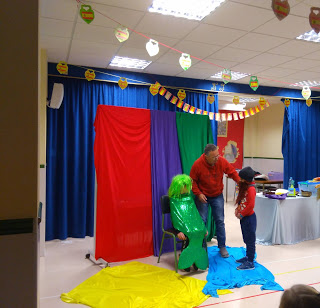LIGHTS, ENGLISH, ACTION!
Image: Alan Kennedy, professional storyteller performing at Narciso Yepes School in Lorca, Spain.
Teaching learners to communicate in a FL requires the use of meaningful and contextualized activities, designed for a specific group of learners; and considering their developmental stage, linguistic and communicative competences, their interests and needs. However, the interaction process in a FL has to be dealt with carefully, so that students progressively advance at their own pace in listening to others to move on to negotiating meanings with their peers through verbal and non-verbal means. As a consequence, the exchange of messages in purposeful tasks will eventually enable them to establish simple real-life communication.
Animation and expression techniques should be considered within the scope of communicative activities, as they provide students with real practice and interaction in the foreign language (FL). Seen in this light, we shall start by presenting a brief overall view of communicative competence and communicative activities.
Interaction can be taken to the FL class through drama activities, since they contribute to promote positive emotions through a controlled communicative exchange or presentation. It is commonly acknowledged that drama provides ideal frameworks for the development of FL communicative competence, since children like learning through enjoyable activities. Moreover, through drama techniques students have the opportunity to be involved in real interaction and express feelings, ideas and information.
Maley and Duff (2005) highlight the reasons for using drama in FL teaching:
- It integrates language skills in a natural way. Careful listening is a key feature. Spontaneous verbal expression is integral to most of the activities; and many of them require reading and writing, both as part of the input and the output.
- It integrates verbal and non-verbal aspects of communication, thus bringing together both mind and body, and restoring the balance between physical and intellectual aspects of learning.
- It draws upon both cognitive and affective domains, thus restoring the importance of feeling as well as thinking.
- By fully contextualizing the language, it brings the classroom interaction to life through an intense focus on meaning.
- The emphasis on whole-person learning and multi-sensory inputs helps learners to capitalize on their strengths and to extend their range. In doing so, it offers unequalled opportunities for catering to learner differences.
- It fosters self-awareness (and awareness of others), self-esteem and confidence; and through this, motivation is developed.
- Motivation is likewise fostered and sustained through the variety and sense of expectancy generated by the activities.
- There is a transfer of responsibility for learning from teacher to learners –which is where it belongs.
- It encourages an open, exploratory style of learning where creativity and the imagination are given scope to develop. This, in turn, promotes risk-taking, which is an essential element in effective language learning.
- It has a positive effect on classroom dynamics and atmosphere, thus facilitating the formation of a bonded group, which learns together.
- It is an enjoyable experience.
- It is low-resource. For most of the time, all you need is a “roomful of human beings”.
When starting to implement drama techniques, Total Physical Response (TPR), developed by James Asher in the 70s, is built around the coordination of speech and action; and attempts to teach the FL through motor activities.
TPR is firstly implemented by getting the students to carry out single actions following simple commands, to move on to more complex sequences of two or three actions, sometimes involving imaginary contexts or games (i.e., “Simon Says…”; or “Do what the puppet says…”). As it can be derived from this assertion, imperative drills to elicit physical actions are the most common classroom activities; whilst dialogues and conversations are postponed until basic instruction has been accomplished.
The central processes in this method can be summarized in three points:
- Children develop listening competence before they develop the ability to speak.
- Children´s ability in listening comprehension is acquired because they are required to respond physically to spoken language in the form of parental commands.
- Once a foundation in listening comprehension has been established, speech evolves naturally and effortlessly out of it.
Learning a FL effectively involves dealing with the four linguistic skills (listening, speaking, reading and writing), but also with sociocultural aspects and an indispensable learning factor: willingness to communicate in the FL. In this sense, animation and expression techniques play a decisive role, since they contribute to engage learners in meaningful and contextualized situations in which they can use the FL with a purpose.
In this light, drama activities foster communication in the FL since they provide subconscious learning through play and enjoyment. Without any hesitation, drama is a pedagogical technique used to develop language skills and communicative competence through motivating activities.
On the other hand, drama techniques are essential to push students to take the risk in an optimal learning environment. As we have seen along this presentation, there are plenty of reasons to use drama activities in FL teaching; however, perhaps the most important one has to do with the intrinsic motivating power of these activities.
The scope of topics and situations for drama activities is highly significant, ranging from daily situations to stories and tales or invented frameworks; however, in all these situations students shall be encouraged to participate and use the FL actively.
MALEY, A. and DUFF, A. “Drama Techniques: A resource book of communication activities for language teachers” (Third edition). 2005.
https://www.youtube.com/watch?v=B8vQbXFrVP4
Video by: Cambridge University Press ELT




